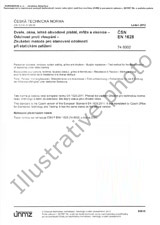We need your consent to use the individual data so that you can see information about your interests, among other things. Click "OK" to give your consent.
ČSN EN 16923 (560136)
Foodstuffs - Determination of T-2 toxin and HT-2 toxin in cereals and cereal products for infants and young children by SPE clean up and HPLC-MS/MS
Translate name
STANDARD published on 1.5.2023
The information about the standard:
Designation standards: ČSN EN 16923
Classification mark: 560136
Catalog number: 516551
Publication date standards: 1.5.2023
SKU: NS-1141984
The number of pages: 32
Approximate weight : 96 g (0.21 lbs)
Country: Czech technical standard
Category: Technical standards ČSN
The category - similar standards:
Cereals, pulses and derived productsPrepackaged and prepared foods
Annotation of standard text ČSN EN 16923 (560136):
This document describes a method for the determination of T-2 toxin and HT-2 toxin in cereals and cereal-based products, e.g. oats, intended for nutrition of infants and young children by high performance liquid chromatography (HPLC) coupled with tandem mass spectrometry (MS/MS) after cleanup by solid phase extraction (SPE) [5].
The method has been validated for HT-2 toxin in oat flour at levels of 9,3 µg/kg and 28,1 µg/kg, oat flakes at levels of 16,5 µg/kg and 21,4 µg/kg, and breakfast cereals (containing oat flakes) at a level of 8,1 µg/kg and for T-2 toxin in oat flour at levels of 4,4 µg/kg and 8,3 µg/kg, oat flakes at levels of 4,9 µg/kg and 6,6 µg/kg and breakfast cereals (containing oat flakes) at a level of 3,5 µg/kg.
Laboratory experiences [6] have shown that the method is also applicable to highly swelling materials (dry cereal-based porridges and modified starches), but these were not examined in the method validation study. Details are outlined in 7.3.
The method can also be applied to oat-by-products at higher levels of T-2- and HT-2 toxin. In this case, the dilution steps need to be considered [6].
The method can also be applied to cereals and cereal products for infants and young children based on e.g. wheat, barley and rice. In this case, the method needs to be in-house-validated for each material. At the time of the interlaboratory study, planned range was 10 µg/kg to 100 µg/kg, and it is known from the pre-study that the method works well in the whole range, although final validation was only done in the range from 3,5 µg/kg to 28,1 µg/kg
Preview of the standard ČSN EN 16923 (560136)
We recommend:
Technical standards updating
Do you want to make sure you use only the valid technical standards?
We can offer you a solution which will provide you a monthly overview concerning the updating of standards which you use.
Would you like to know more? Look at this page.




 Cookies
Cookies
